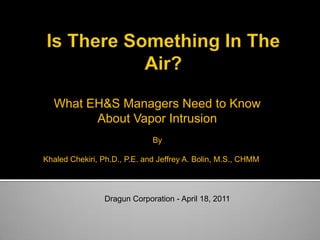
Is There Something In The Air April 18 2012
- 1. What EH&S Managers Need to Know About Vapor Intrusion By Khaled Chekiri, Ph.D., P.E. and Jeffrey A. Bolin, M.S., CHMM Dragun Corporation - April 18, 2011
- 2. 2
- 3. Regulatory concerns Property transaction concerns Legal liability Health concerns 3
- 4. USEPA VI Path November 2002: EPA Draft VI Guidance (not applicable to petroleum) March 2011: EPA solicited (more) comments September 2011: Petroleum guidance February 2012: Technical updates November 2012: Final VI Guidance (expected) 4
- 5. 2004 – 7 States (Including Michigan) 2010 – 32 States 2012 – 32 + 5
- 6. Re-openers? What do you mean it’s not closed? 6
- 7. Anywhere there is “potential” from a previous release. Notable VI sites include Love Canal in Niagara Falls, NY - 70's Hillside school in Needham, MA - 80's Redfield site in Denver, CO. - 90's Bishop St. site in Cambridge, ON. - 00's 7
- 8. Buying/Selling Property Merger/Acquisition Confusion = Delays = $$$ 8
- 9. All Appropriate Inquiries (AAI) ASTM 1527-05 Vapor Encroachment Condition (VEC) ASTM 2600-10 9
- 10. Where is your site relative to a known plume? …or just within an AOC? Non-petroleum hydrocarbon 1/3 mile (1,760 feet) Petroleum hydrocarbon 1/10 mile (528 feet) 10
- 11. AAI Continuing Obligations Michigan Due Care 11
- 12. Employee Exposure? What is an “okay” exposure? ACGIH, PEL, Something Else? 12
- 13. Diffusion ~ slow vs. advection Fick’s Law: Movement of molecules from a high concentration to a low concentration Mass Movement (Flux) = D dC/dx 13
- 14. α= Cindoor air Csoil vapor 14
- 15. Safety Economics Social Time constraints Defensible results 15
- 16. Critical thinking Conceptual site model Multiple lines of evidence Other considerations Sampling methods 16
- 17. Does it make sense? Data validation Screening levels 17
- 18. Geology Water table Contaminant Underground utilities Sensitive receptors Existing and potential future buildings 18
- 19. Indoor air Soil vapor (deep and shallow) Groundwater Background concentrations (ambient air) Building construction Soil stratigraphy Chemicals (presence, ratios) Temporal patterns (heating and cooling) 19
- 20. Access agreements Regulator involved? Risk communication Potential litigation 20
- 21. Background sources Sample custody Temporal variability Multiple home visits 21
- 22. Passive Active 22
- 23. Sub-slab probes Soil vapor points 23
- 24. 24
- 25. 25
- 26. Source remediation Mitigation Institutional controls 26
- 27. Sebawaing, MI Port Huron, MI Salina, KS 27
- 28. Soil Vapor Points 28
- 29. Properly assessing VI is complicated; it requires well thought-out strategy and execution – as with all data GIGO. VI may or may not be part of environmental due diligence or other environmental assessments – it should be on your checklist to ask if it has been evaluated. Don’t rush to remediate or mitigate based on VI data; do the data make sense? 29
- 30. Contact Information: Khaled Chekiri, Ph.D., PE (kchekiri@dragun.com) Jeffrey A. Bolin, M.S., CHMM (jbolin@dragun.com) 30